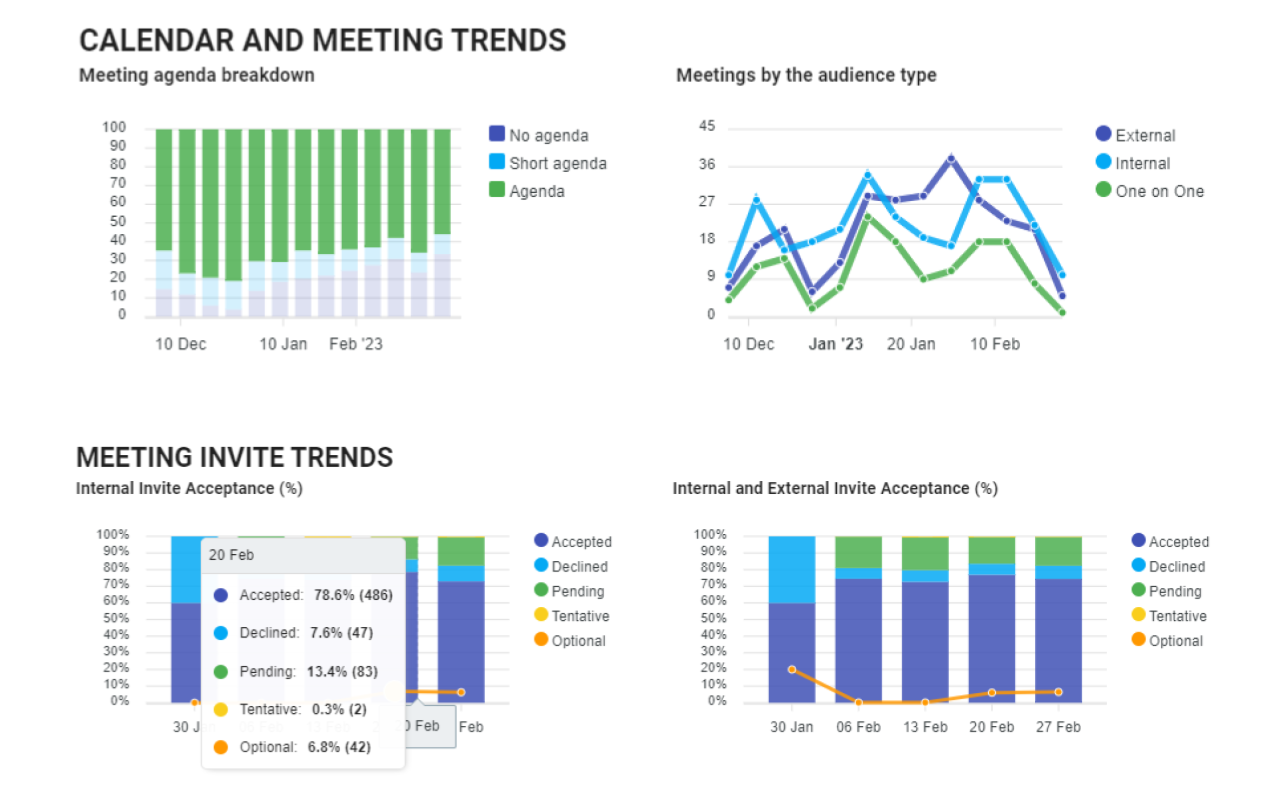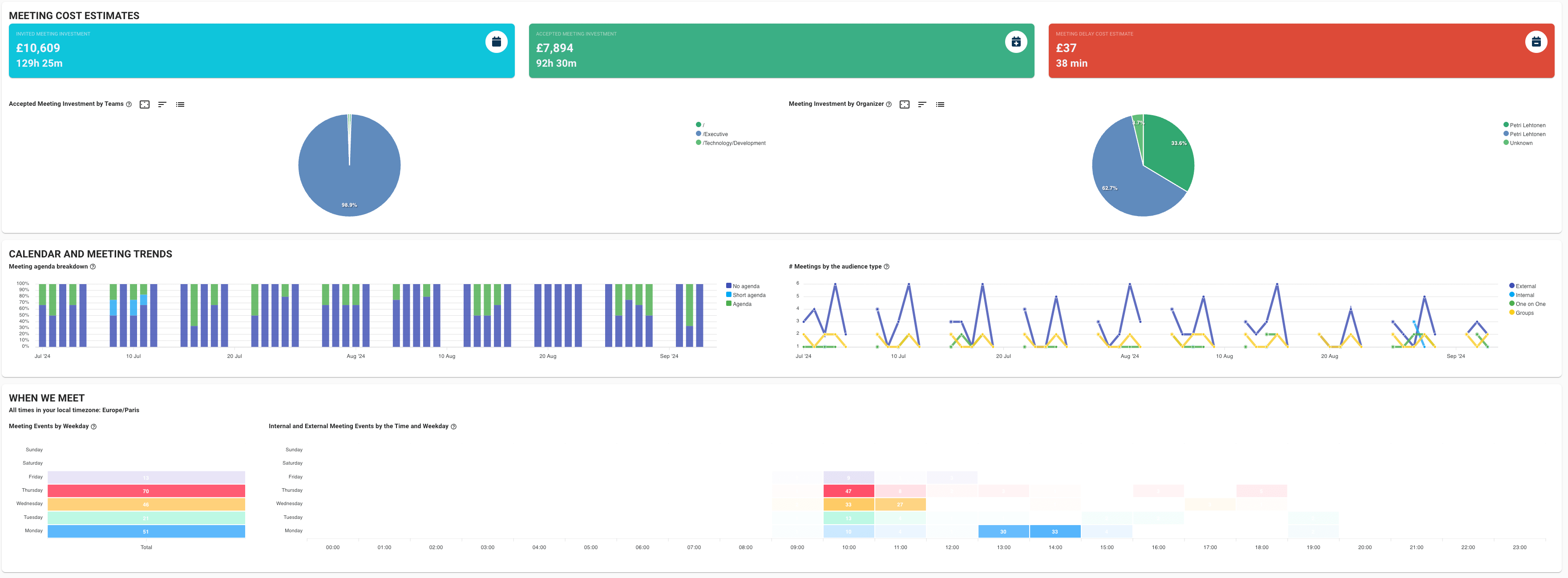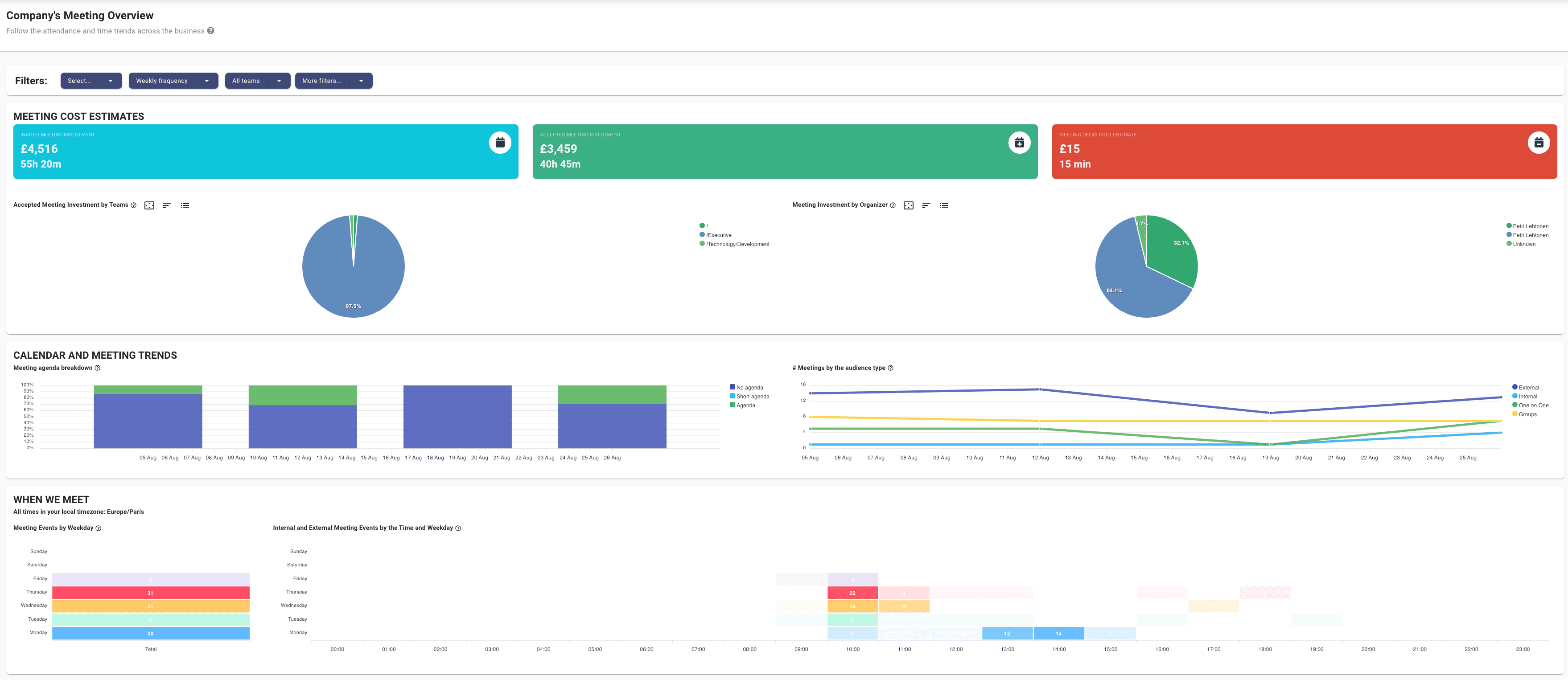Calendar Analytics vs. Meeting Analytics vs. Meeting Note Takers
Discover how Flowtrace integrates calendar analytics, meeting analytics, and video call analytics to revolutionize time management and collaboration...
Run better company meetings by redesigning systems, tracking data, and treating meeting time as a strategic investment to boost productivity and collaboration using Flowtrace.
Meetings are one of the most expensive recurring costs inside any company, and yet, they’re rarely tracked, measured, or managed with the same rigor as budgets or headcount.
It’s not that teams don’t care. It’s that most advice on “how to run better meetings” stops at surface-level tactics: write an agenda, keep things on time, send out notes. Helpful? Sure. But not enough.
Running better meetings isn’t about being a better host, it’s about being a better operator. It’s about understanding how meeting time is being used across the entire organization, what it’s costing, and whether it’s delivering real value.
At Flowtrace, we believe meetings should be treated as strategic investments. That means visibility into who’s meeting, why, and how often. It means having systems that flag inefficiencies before they pile up. And it means building a culture where time is respected as seriously as budget.
If you want to fix your meetings, don’t just improve facilitation. Redesign the system they operate in.
Most companies don’t know how much they meet, why they meet, or who’s in the room, and the result is a meeting culture built on habit, not strategy.
A simple fix? Start with a 30-day meeting audit. With the right tools, you can automate this process and surface clear insights into meeting volume, frequency, and distribution by team or role. Platforms like Flowtrace make it easy to spot the hidden patterns dragging your productivity down.
Are certain teams meeting twice as much as others? Is one recurring sync eating 12 hours a week across departments? Are the same attendees booked in back-to-back calls every day?
By identifying trends like attendance bloat, repeat topics, unclear ownership, or meetings without agendas, you expose the invisible inefficiencies sapping team time.
You can’t improve what you can’t see. Audit before adjusting and treat your calendar data as seriously as your financials.
Not all meetings are created equal, and treating them as such can lead to inefficiencies and wasted time.
Every organization should establish clear definitions for different meeting types: tactical syncs, strategic decision meetings, brainstorming sessions, 1:1s, and retrospectives. Each type serves a distinct purpose and should follow its own set of norms regarding objectives, format, and duration.
Creating templates and expectations for each meeting type ensures that everyone understands the goal, structure, and necessity of the meeting. For instance, decision meetings should conclude with clear ownership and action items, while brainstorming sessions should foster creativity without the pressure of immediate decisions.
Selecting the right meeting participants is equally crucial. Overpopulated meetings can dilute focus and hinder decision-making. By carefully curating the attendee list, you ensure that each participant is essential to the discussion, enhancing efficiency and engagement.
According to a study published in the Harvard Business Review, 71% of senior managers reported that meetings are unproductive and inefficient, often due to unclear purposes and poor structure.
Flowtrace assists teams in mapping out their existing meeting types and frequencies, analyzing where time may be lost due to improper formats or cadences. This analysis is a key step in identifying meetings that could transition to asynchronous updates or be eliminated altogether.
Don’t attempt to standardize all meetings uniformly. Instead, standardize by category, designing each to achieve its specific outcomes effectively.
Every meeting invite should start with a simple question: Why this meeting? Why these attendees? Without a clear reason, it shouldn’t be on the calendar.
That’s the power of a meeting justification rule, forcing intentionality into every invite. It’s a lightweight but effective way to eliminate calendar clutter and prevent the steady creep of unproductive recurring meetings.
Teams using Flowtrace can configure this process directly: the platform flags vague invites, tracks agenda usage, and highlights recurring meetings with no outcomes or engagement. It becomes easy to see which meetings are driving progress and which are wasting time.
It also shines a light on invitee selection patterns: Are the same people being invited by default? Are decision-makers being left out?
The goal isn’t to create friction, it’s to build a habit of thinking before booking.
Flowtrace doesn’t just show you where time is going. It gives you the structure to stop bad meetings before they happen.
If there’s no agenda, there’s no meeting. Full stop.

But it’s time to go beyond the outdated idea of agendas as simple prep tools. A good agenda should act as a filter for relevance. It answers a critical question: Does this need to be a meeting at all, or can it be handled asynchronously?
Flowtrace’s calendar agenda validation feature does exactly this. It scans invites for agendas, flags missing ones, and prompts organizers to reconsider whether a meeting is necessary before it ever hits the team’s calendar.
Agendas also set expectations. They make it clear what will be discussed, who’s responsible for which items, and what outcomes are expected. This naturally ties into meeting cost awareness: the clearer the purpose, the more justified the time investment.
In a company where everyone is back-to-back in calls, an agenda isn’t just a helpful document, it’s your spam filter. It protects focus time, aligns priorities, and makes sure that meetings serve a real function in your workflow.

Ending a meeting with clear action items, owners, and deadlines is a good start, but what happens after the call matters even more.
Without follow-through, even the best-run meeting becomes a waste of time. That’s why teams need post-meeting analytics to track what actually gets done. Who’s consistently booking meetings with no outcomes? Who never follows up? Are the same meetings being repeated week after week with no resolution?
Flowtrace helps you close that feedback loop with visibility into meeting impact and accountability. It connects meeting data, like attendance, agenda usage, and action tracking, to real behavior.
It also helps identify patterns of meeting bloat, poor follow-through, and time-wasting syncs that never move projects forward.
“Did this meeting work?” shouldn’t be a gut feeling. It should be a data point, something you can measure, review, and improve. Flowtrace makes that possible by turning meetings into a measurable, improvable process, not just a calendar event.
It’s not just about who’s in the room, it’s about who’s being heard.
Are junior team members consistently silent? Are women or underrepresented colleagues missing from critical decision-making discussions? These patterns often go unnoticed until they become cultural problems, and by then, the damage is done.
Flowtrace helps surface these issues through data. With visibility into meeting participation trends, organizations can detect exclusion patterns, inconsistent contributions, or repeated silencing of certain voices.
Meeting feedback analytics can also help teams understand who’s engaging, who’s being overlooked, and what that means for inclusion and decision-making quality.
This kind of visibility enables early intervention, not just to be fair, but to make better decisions.
Async-first? Deep work culture? Hybrid or distributed teams?
Your meeting structure should reinforce, not contradict, your operating philosophy. If your company claims to protect focus time but fills every afternoon with status meetings, you’re sending mixed signals. If you promote autonomy but require leaders to attend every decision meeting, you’re creating bottlenecks.
Flowtrace helps you align meetings with your broader way of working. With visibility into how time is spent, which roles are overloaded, and how meetings evolve, you can start to change your meeting culture intentionally, not reactively.

Want to prioritize deep work? Use Flowtrace to surface where meetings interrupt focus blocks or clash with protected time. Going async-first? Identify recurring meetings that can shift to documentation or Looms instead.
And in hybrid setups, it’s especially important to track how different locations or roles are affected. Are remote employees included in key discussions? Are meetings optimized for in-person teams only?
Redesigning meeting systems to match your operating model doesn’t just improve time use, it strengthens the culture you're trying to build.
Meetings are a cultural infrastructure. Design them with intent.
People treat calendar time like it’s free. It’s not. Every meeting has a price tag, whether you track it or not.

One of the fastest ways to change meeting behavior is to visualize the true cost. When teams see the salary-weighted value of a 10-person, 60-minute meeting, priorities shift. Suddenly, that weekly sync looks a lot more expensive and a lot less urgent.
Flowtrace makes this simple. It uses your team’s calendar data and role-based benchmarks to display meeting costs inside dashboards, meeting invites, or reports. That transparency nudges people to rethink frequency, duration, and attendee lists.
You can also track long-term trends across departments with meeting cost indicators. See which teams are booking high-cost recurring meetings. Identify where time is being spent without results. Spot opportunities to reduce bloat without sacrificing collaboration.
The result? Fewer bloated calls. More intentional time use. And a culture that budgets meetings like it budgets projects.
Sometimes, you don’t need to optimize your meetings, you need to burn them down and start fresh.
A couple of times a year, run a Meeting Reset Week: pause all recurring meetings across the company. No exceptions. At the end of the week, teams must re-justify every meeting they want to bring back. Why does it exist? What’s the goal? Who actually needs to attend?
It’s a simple but powerful reset that helps teams escape the trap of outdated routines and recurring meeting bloat.
Flowtrace helps you track which meetings are truly valuable by showing which ones consistently lack agendas, overrun time, or deliver no outcomes. It also highlights patterns of meeting overload and surfaces which roles are most affected.
After a reset, you’ll be surprised how many meetings simply… disappear.
Don’t waste time optimizing the wrong meetings. Scrap and restart. Give your calendar and your people a clean slate.
If meetings are a team sport, then everyone needs a scoreboard.

Dashboards let individuals, managers, and team leads see exactly how their time is being spent, how many hours are going to meetings each week, who’s attending the most, which meetings cost the most, and where time could be reclaimed.
Flowtrace provides Google Calendar dashboards that break down this data by person, team, and role. It’s not just leadership insight, it’s fuel for team-level optimization.
When people can see their own meeting load, and how it compares over time, they start making smarter decisions. Do I really need to attend this? Can this be async? Why is half my week in recurring meetings?
This kind of transparency supports self-managed meeting improvements instead of top-down mandates. Teams learn to optimize collaboratively, not just compliantly.
Give your teams dashboards, not directives. Let them lead the change.
You don’t fix meetings once, you evolve them continuously.
Effective meeting culture is built on a feedback loop: test policies, measure outcomes, iterate. Maybe you shorten default durations. Cap attendees. Shift status updates to async. The point isn’t to get it perfect on the first try, it’s to treat meetings like a system that gets better with data.
Flowtrace enables this kind of iteration with visibility into your meeting health. You can track how changes affect meeting costs, focus time, agenda usage, and participation patterns. You’ll know which shifts are working and where further tweaks are needed.
This level of refinement is what separates surface-level fixes from true meeting transformation. It turns meetings from a time sink into a performance lever.
Treat your meeting system like your product. Monitor usage, ship updates, and improve with every release.
Most companies chase tactics when they really need systems. Running better meetings isn’t about another checklist or productivity hack, it’s about changing how your organization thinks about time, collaboration, and decision-making. The future of effective collaboration is measurable, adaptive, and intentional, and Flowtrace gives you the infrastructure to make it happen.
Discover how Flowtrace integrates calendar analytics, meeting analytics, and video call analytics to revolutionize time management and collaboration...
Transform your company's approach to meeting management with a strategic, data-driven system that improves efficiency, reduces overload, and fosters...
Discover how an executive meeting dashboard optimizes time, improves meeting culture, and reduces costs by transforming calendar data into actionable...